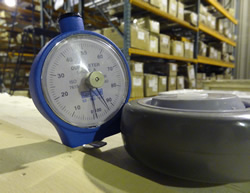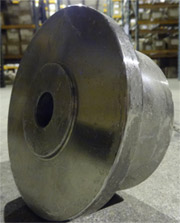
While looking at casters and caster wheels, you may have come across the terms “Durometer” or “Shore Durometer” and an associated number and letter. What do they mean? Where did they come from? Why are they there? Read on to find the answer to these life-changing questions.
Lets get the confusing part out of the way first. Durometer is both a measurement and a tool for measuring. In other words, you measure the durometer of an item with a durometer.
But what exactly is a durometer measuring? The hardness of an item. There are many durometer scales represented by a letter(in the caster and wheel industry we use Shore A and Shore D) ranging in numerical value from 0-100. The higher the number, the harder the item is on that particular scale. For instance, a rubber band has a durometer of 25 A. Skateboard wheels (or many of the polyurethane wheels we sell) might be between 85-95 A. This doesn’t mean that they are extremely hard, just that they are one of the hardest materials the Shore A scale can measure.
What happens when an item is harder than the Shore A Scale can measure? That’s when we move on to the Shore D scale. Any of our harder wheels, such as a phenolic resin wheel, will be measured on the D scale. A phenolic resin wheel has a durometer of 90 D. Another example of an item on the D scale would be a hard hat, which has a durometer of around 75 D.
Ultimately, the durometer of a wheel can help the user figure out how the wheel will react to its environment and the floor it is on. Will it be durable enough? Will the wheel damage the floor? Will the floor damage the wheel? Will the wheel roll over debris? These questions can be answered (or at least approximated) through the use of durometer measurements.
 Flanged wheels set themselves apart from other wheels by having a lip around one or both outside edges of the wheel. Most people will be familiar with flanged wheels as those on trains or old mining carts, however they are popular for many industrial and factory setting applications.
Flanged wheels set themselves apart from other wheels by having a lip around one or both outside edges of the wheel. Most people will be familiar with flanged wheels as those on trains or old mining carts, however they are popular for many industrial and factory setting applications.